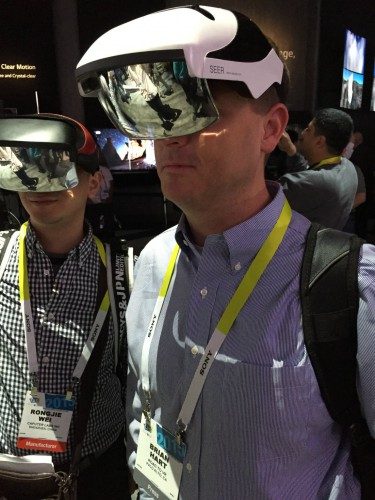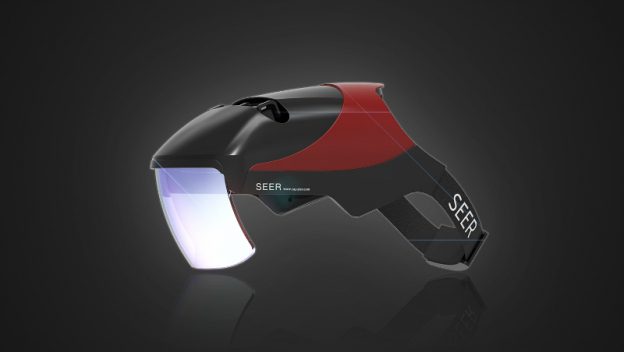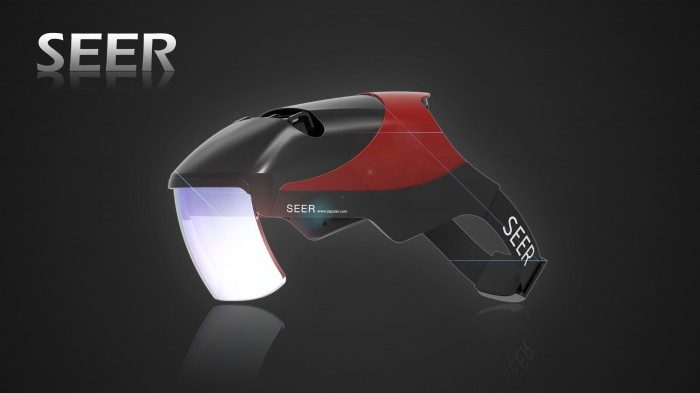SEER, an augmented reality device from San Francisco/Shenzhen based Caputer Labs Inc, launched their Kickstarter campaign in late January, and have already reached beyond $75,000 of their $100,000 funding goal. The device, which takes advantage of the user’s smartphone, boasts having the “world’s largest FOV” (field of view) at 100 degrees.
Like many recent crowdfunding campaigns, Caputer Labs used this year’s CES conference in early January as a jumping off point to help garner interest from potential funders, and within only 3 days of the campaign’s open, the startup, which is split between San Fransico and Shenzhen offices, had already reached an impressive 25 percent of their initial funding goal—clear evidence of brewing interest in the smartphone-driven headset, which has now passed $75,000 in funding—but what is SEER, and how does it deliver such a wide FOV?
We’re pushing past the less than credible notions that SEER is “the first AR helmet that makes you a real Iron Man,” as evidenced by the fact that the device doesn’t come with a reactive exoskeleton, embedded fusion reactor, rocket boots, or Paul Bettany’s voice as J.A.R.V.I.S., Iron Man’s foppish AI sidekick. Marketing silliness aside, what the headset purports to do is offer a unique optical lens and mirror system that reflects the image from your smartphone to a specially coated shield, allowing for projected images to take up to 100 degrees FOV—about the same as the Oculus Rift DK2 for comparison’s sake.
With no mention of using the phone’s camera for sensing the outside world or for use as input, SEER may be better qualified as a heads-up-display (HUD) headset than a true AR headset, which would be capable of augmenting/interacting with the world around the user, not merely projecting an image on top of it. Alas, the term ‘augmented reality’ is sprinkled throughout the Kickstarter page.
Without an individual image for each eye, we were unsure how the device would be able to display an image that wouldn’t be prone to eye strain, considering that the display is projected just a few inches away from the eyes, so we reached out to Caputer Labs’ founding member and business lead, Baicheng Hou, for more information:
…SEER is not stereoscopic 3D at this stage and it uses a specific optics algorithm which is embedded in the lens to properly redistribute images to each eye. The image itself is displayed at a distance of 0.3-7 meters, depending how you adjust the lens, instead of being right in front of the eyes.”
 Although Road to VR’s Brian Hart got a chance to try on the prototype device, due to the whirlwind pace of CES, he didn’t have a chance to give SEER more than a few minutes of his time—not long enough to determine if the close proximity of the image’s convergence point might lead to eye fatigue.
Although Road to VR’s Brian Hart got a chance to try on the prototype device, due to the whirlwind pace of CES, he didn’t have a chance to give SEER more than a few minutes of his time—not long enough to determine if the close proximity of the image’s convergence point might lead to eye fatigue.
The campaign has added the option of purchasing a dedicated display for an extra $99 that would substitute the user’s personal smartphone with a 5 inch IPS-LCD, that would allow the headset to display output from game consoles and PCs, via an HDMI connection. Caputer Labs also claims “SEER can also become a VR-like helmet,” using a light field to block the transparency of the projection screen, though we’re not clear on how well that experience would turn out, and it isn’t clear if the blocker is included with the headset.
Despite a number of potential marketing misgivings, SEER is comfortably priced, starting with limited early-bird tiers of the headset at $79, $89, and $99, with the first unlimited quantity tier running $119 with free shipping to the continental United States, a price-point that could offer developers an inexpensive dev kit to get started in the world of see-through displays.
SEER will come in ‘Artic White’ and ‘Jet Black’ variants, and is estimated to ship to backers in September 2015.
Seebright Wave, another smartphone-based AR headset that we wrote about recently, similarly claimed to have “the widest field-of-view of any see-through display out there,” though the Wave affords a stereoscopic image (while SEER does not) which may factor into the claim. We’ve reached out to Seebright for comment. Granted, neither device is being manufactured yet!








